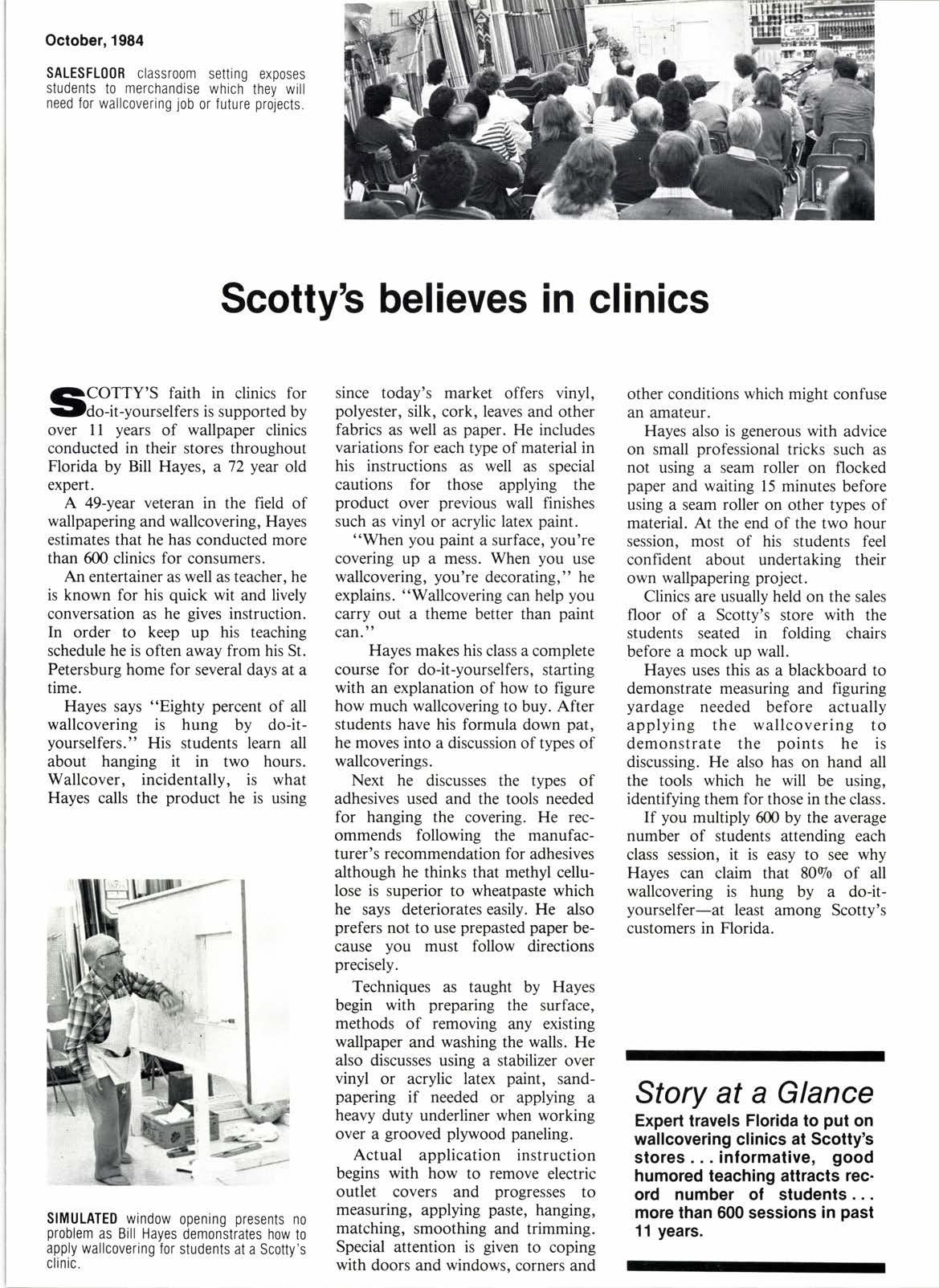
2 minute read
Scotty's believes in clinics
S;"'-;l lil:'""ft :l' Jilffi
:,
T;
over I I years of wallpaper clinics conducted in their stores throughout Florida by Bill Hayes, a 72 year old expert.
A 49-year veteran in the field of wallpapering and wallcovering, Hayes estimates that he has conducted more than 600 clinics for consumers.
An entertainer as well as teacher, he is known for his quick wit and lively conversation as he gives instruction. In order to keep up his teaching schedule he is often away from his St. Petersburg home for several days at a time.
Hayes says "Eighty percent of all wallcovering is hung by do-ityourselfers." His students learn all about hanging itin two hours. Wallcover, incidentally, is what Hayes calls the product he is using since today's market offers vinyl, polyester, silk, cork, leaves and other fabrics as well as paper. He includes variations for each type of material in his instructions as well as special cautions for those applying the product over previous wall finishes such as vinyl or acrylic latex paint.
"When you paint a surface, you're covering up a mess. When you use wallcovering, you're decorating," he explains. "Wallcovering can help you carry out a theme better than paint can."
Hayes makes his class a complete course for do-it-yourselfers, starting with an explanation of how to figure how much wallcovering to buy. After students have his formula down pat, he moves into a discussion of types of wallcoverings.
Next he discusses the types of adhesives used and the tools needed for hanging the covering. He recommends following the manufacturer's recommendation for adhesives although he thinks that methyl cellulose is superior to wheatpaste which he says deteriorates easily. He also prefers not to use prepasted paper because you must follow directions precisely.
Techniques as taught by Hayes begin with preparing the surface, methods of removing any existing wallpaper and washing the walls. He also discusses using a stabilizer over vinyl or acrylic latex paint, sandpapering if needed or applying a heavy duty underliner when working over a grooved plywood paneling.
Actual application instruction begins with how to remove electric outlet covers and progresses to measuring, applying paste, hanging, matching, smoothing and trimming. Special attention is given to coping with doors and windows, corners and other conditions which might confuse an amateur.
Hayes also is generous with advice on small professional tricks such as not using a seam roller on flocked paper and waiting 15 minutes before using a seam roller on other types of material. At the end of the two hour session, most of his students feel confident about undertaking their own wallpapering project.
Clinics are usually held on the sales floor of a Scotty's store with the students seated in folding chairs before a mock up wall.
Hayes uses this as a blackboard to demonstrate measuring and figuring yardage needed before actually applying the wallcovering to demonstrate the points he is discussing. He also has on hand all the tools which he will be using, identifying them for those in the class.
If you multiply 600 by the average number of students attending each class session, it is easy to see why Hayes can claim that 8090 of all wallcovering is hung by a do-ityourselfer-at least among Scotty's customers in Florida.
Story at a Glance
Expert travels Florida to put on wallcovering clinics at Scotty's stores.. informative, good humored teaching attracts record number of students... more than @0 sessions in past 11 years.










